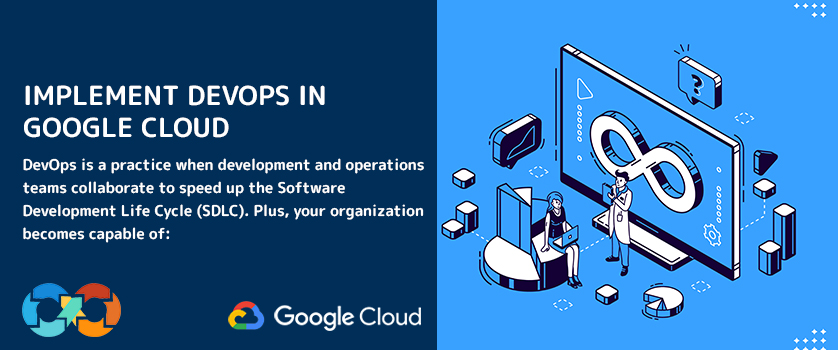


DevOps is a practice when development and operations teams collaborate to speed up the Software Development Life Cycle (SDLC). Plus, your organization becomes capable of:
But the problem is how to find a Cloud platform if you’re a newbie. And the irony is that the problem seems stellar even if there are multiple cloud vendors available.
Right now, AWS and Azure enjoy a market share of 51%. Still, there are other platforms available that are as good as these two.
For instance, Google Cloud is one of the rising Cloud service providers, but it has a micro share (around 7%).
This is the reason people go for other platforms instead of GCP. Apart from that, people also think that DevOps principles can’t be implemented on GCP, which is a lie.
And in this article, we are going to tell you how you can implement DevOps in Google Cloud.
Continuous Integration is the practice of allowing developers to merge code into a central repository like Github. Thus, it is mandatory to have a CI server build and validate code with a series of automated tests. CI can work well if it has a wide coverage of your codebase in order to confidently know that any integrated code will not cause issues further in the pipeline. If a commit to the central repository fails any tests, it’s not integrated with the codebase, and the developer can fix it immediately.
You will encounter many barriers while investing in a CI/CD pipeline because it requires time for creating robust integration testing of newly developed code. The reason behind this is: when a CI/CD pipeline that produces inaccurate results will end up causing more headaches and wasting more time than before.
However, you can do it in a simple way and still avoid such hassles. You should inculcate a cultural shift towards code testing and start small with unit tests. These can usually be created by developers before they commit to the central repository, and it’s a perfect, granular building block before moving up to Integration tests and System tests.
If you’re already hosting your application in Google Cloud Platform on Kubernetes Engine, the infrastructure for automated deployment won’t be difficult. Kubernetes comes with many automation tools supported by GCP, and it will ease out DevOps for you. After including this tool in your pipeline, your QA engineers won’t have to focus on build issues.
Besides Kubernetes, there are various tools that you can choose from like Jenkins, Spinnaker, CircleCI, Gitlab, and TeamCity. But your ultimate decision will depend on your codebase and business needs.
A solid CI foundation is a must for Continuous Delivery (CD). In a culture of continuous delivery, dev teams avoid frustrating development downtime that results from massive deployments, where no one is allowed to touch the codebase. Instead, the CI server monitors rolling commits to the codebase, run tests, and queues the application for deployment that too with a click of a button. When coupled with a microservices architecture, this results in an environment of multiple production deployments per day.
When frequent deployments happen at such a level, you can employ real-time monitoring through Stackdriver Monitoring on Google Cloud. This enables the team to catch any issues that were not apparent in testing, and any issue that makes it into production serves to inform the QA team of how to improve testing coverage to eliminate the issue in the future.
To successfully implement the DevOps principle on any platform, you should focus on setting up a CI/CD pipeline. This pipeline covers all the major tasks, including build, test, and deployment. However, certain platforms make it easy to set up your pipeline, as they provide some in-built features. Initially, when you compare such platforms with relatively newer platforms like GCP, you will find that GCP lacks features, but it is merely a misconception. Most platforms like GCP offer third-party integration with multiple tools that ease the process of setting a pipeline.
Moreover, if you feel stuck at any stage, hire DevOps experts, discuss your requirements with them, and let them make a detailed DevOps strategy for your organization.